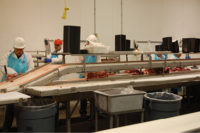Recently, I managed a brownfield project that included a significant amount of demolition. In the decommission phase of the project, older equipment was inventoried and assessed for repurposing. While evaluating the conveyors, I was amazed at the variety of designs, belting, fabrication and, unfortunately, poor sanitary design.
Additionally, in a previous role as a director of process automation and technology for a major processor, my team and I had an interesting discussion about the possibility of creating a generic conveyor design. This design would use common parts, construction, drives and belting. It would be a “clean” design and save on fabrication and reduce spare-parts inventories.
Although great in concept, the generic conveyor never materialized. Why? Simply looking at the role conveyors play in meat processing can be overwhelming because different stages require unique applications of functionality. Each application requires customizing conveyors based on process needs, equipment manufacturer and belting.
Few companies manufacture belting. One can’t go to the superstore and buy a conveyor or belting. These manufacturers continue to develop a variety of belts to meet customer needs and their processes.
While evaluating the belting on those old conveyors mentioned above, I noticed opportunities to improve the belt engagement, travel bed and cleanability. Belting company representatives have discussed improving belting performance and cleanability to a microbial level. But designing a “clean” conveyor and using a proper belt cannot ensure proper fabrication.
Designing a conveyor is not easy and fabrication can be made more difficult by complicated designs. Each conveyor and equipment manufacturer has a fabrication process. Some manufacturers will follow methods that have been passed down over decades while others follow a documented and formal process. In either case, the end results will be the processors’ responsibility to maintain and clean for the life of the conveyor.
For these conveyor projects, one can look to the iron triangle of project management defined in the Project Management Book of Knowledge (PMBOK) (Project Management Institute, 2013). The triangle is composed of cost, time and quality. Changes to the original design affect these areas.
If a conveyor is needed more quickly than originally committed, quality and cost may be compromised. You may have heard the statement, “I don’t care what it costs; we need that conveyor installed this weekend.”
Rushing a job may lead to poor quality welds, missed welds and, of course, higher costs. Yet, fabricating conveyors doesn’t need to be a processor’s Achilles’ heel. Proper design, appropriate belting and consistent fabrication can provide a lasting asset for a facility.
Of course, there is always room for continued improvement. Some manufacturers continue to explore and implement methods for improving the designs, fabrication and sanitation of conveyors.
It has been more than 15 years since the first Guidelines for Sanitary Design Principles were developed, and more than three years since the revised guidelines were published. Is it too early to look for Sanitary Design Principles 3.0? Perhaps not.
Looking to the future, more conveyors are being used, which means more food surface contact and transfer points. Working with conveyor manufacturers can improve your facility’s overall performance and cost of ownership. A number of manufacturers are highly advanced and are progressing to eventually get to the “perfect conveyor” design. NP








